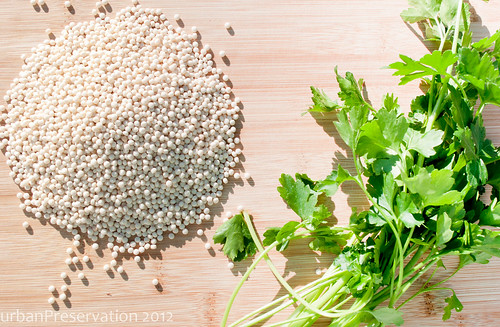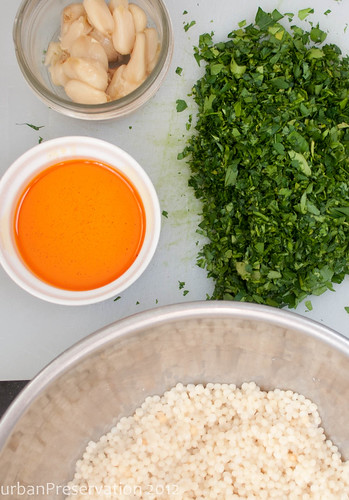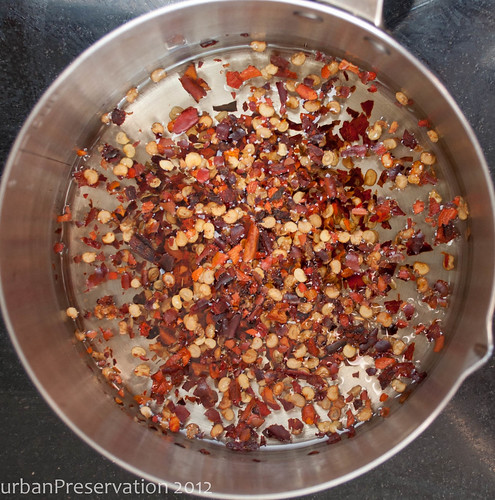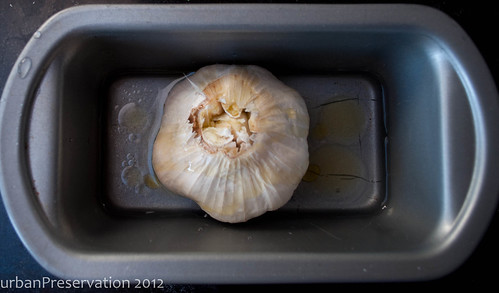
Then I fell in love with chimichurri sauce. I loved the tang and the heat, but mostly I loved the clean, grassy, herbal flavor of the parsley that makes up the majority of the sauce. There are of course about as many variations of chimichurri as there are people who make it, but most recipes agree that parsley plays a key role, if not the sole herbal element. So when my roommate bought an extra bunch of parsley and asked if I wanted to use it, I had a good idea where it was going to end up.

Chimichurri as a sauce on already cooked foods is great but as a dressing for an Israeli couscous salad it leaves sometimes to be desired. The chile flakes that distribute heat so well through the oil and vinegar provide an uneven heat when mixed into a salad. Some bites have too much heat, some none at all. The raw garlic that’s traditional in chimichurri also doesn’t play nice in a room temperature salad. Without something rich and fatty to cut through, the sharpness of the garlic tends to overwhelm just about everything, including my breath for the next day or so. Those flavors are still really important to the finished product so I gave them both a bit of a pick me up to help them meld better in the final dish.

To tackle the chile flakes I infused them into some neutral oil to mix into the final dish. Infused oil is a great way to evenly distribute a dried herb throughout a salad. Add the herbs to cold oil and put it over medium heat for a few minutes until the oil takes on the scent of the herb. Then strain it and bottle it for future use. The chile oil added a nice even heat to the couscous and it doesn’t hurt that the dried chile flakes dye the oil a brilliant orange. To mellow the garlic I used roasted cloves instead of fresh which added the garlic flavor without the sharp sting. Even if you’re not making this dish, roasted garlic is a great thing to have around to add to recipes or just to spread on good bread with some quality olive oil. Additionally, the soft garlic can be a great addition to salad dressing since it will dissolve into the vinegar with a little whisking.

The final dish has a good amount of heat and some sweet nuttiness from the roasted garlic, but it’s the parsley that really steals the show. Green and herbal, it’s a great example of how an overlooked ingredient can make a huge difference in a dish.
Note: I made this with Israeli couscous because it’s what I had around the house. Would it be equally delicious with other grains, including regular couscous, barley, farro, quinoa, and pasta? You bet.
Chimichurri Couscous
1 cup uncooked Israeli couscous
2 cups water or chicken stock
1 tbs salt + additional for seasoning
1/3 cup neutral oil, such as canola or safflower
1 tbs red chile flakes
¼ cup red wine vinegar
4-6 cloves roasted garlic (recipe below)
1 large bunch flat leaf or Italian parsley, finely minced
Bring the water or stock to a boil in a medium pot and add the Israeli couscous and the salt. Stir in the couscous and cook for 6-8 minutes or until couscous is tender all the way through. Drain and set aside.
Place the oil in a small pot and add the chile flakes to the cold oil. Place it over medium low heat and cook for 5 minutes or until oil takes on the scent of the chile flakes and turns a bright orange color. The longer it cooks the spicier the oil but avoid burning the chile flakes which will make the oil bitter. When oil reaches the desired spice level, take it off the heat and strain out the chile flakes.
Mash garlic cloves into vinegar and whisk until garlic is fully incorporated. Mix vinegar/garlic mixture with oil to create a loose vinaigrette. Combine vinaigrette, couscous, and parsley and stir to distribute evenly. Taste to adjust seasoning. Serve warm or at room temperature.

Easy Roasted Garlic
1 head raw garlic
2 tbs olive oil
Preheat your oven to 400F. Place the garlic in a small baking dish and add water to come a quarter inch up the side of the dish.* Pour the olive oil over the garlic head and cover with foil. Roast for 1 hour or until garlic cloves are soft to the touch. Let cool and peel cloves. Store peeled cloves in a well sealed container in the fridge. Avoid plastic if possible because it can hold the smell of garlic even after washing.
*Roasting the garlic in a small amount of water prevent the bottom of the garlic from burning and adding a bitter flavor to the roasted cloves.
No comments:
Post a Comment